1 March - Thinking about ULEZ, Part 5
No one can doubt the amount of work that has gone into @tonyofsidcup’s contribution to the ULEZ debate but I feel that it is a little short on democracy.
The extended ULEZ was not in Khan’s manifesto. He said he would be mindful of
the consultation but he wasn’t, even if you overlook the disappearance of 5,000 probably dissenting voices.
The timing isn’t right. There is a cost of living crisis and car pollution
levels are rapidly declining. It is a money grab and the expenditure can only be
justified if it is the precursor to road charging which we now know it is.
It wouldn’t be fair to attempt to systematically destroy Tony’s input after offering
him the opportunity to make his research more widely available but even if I accept everything
he says it still comes across as something that might have been written by someone who was schooled in the
U.S.S.R. rather than what used to be a Western democracy.
My own view can perhaps be most simply made clear by this photo montage.
All five of Tony's essays are available here.
Thinking about ULEZ, Part 5 - Gone Girl
Meet Geoff, an up-and-coming YouTuber who has found an enthusiastic audience - 34,700
subscribers and counting! - by recording videos against ULEZ, road charging, LTNs and all that woke
nonsense. In his recent video, Geoff holds out an article by the Centre for London, “London’s
independent think tank”, alluding to the dangers of air pollution. Geoff is not impressed. “As we well
know from Sadiq Khan’s recent actions, he just makes the numbers up as he goes along”, says Geoff,
“If he wants to think that 40,000 people have died from air pollution, then that’s what he says. But
there is no evidence to back it up!” Geoff has evidence of his own, an official document which says,
in black and white: “There was 1 death registered in London in the period 2001 to 2021 which had
exposure to air pollution recorded on the death certificate”. Khan’s lie is spectacularly busted, and Geoff moves on.
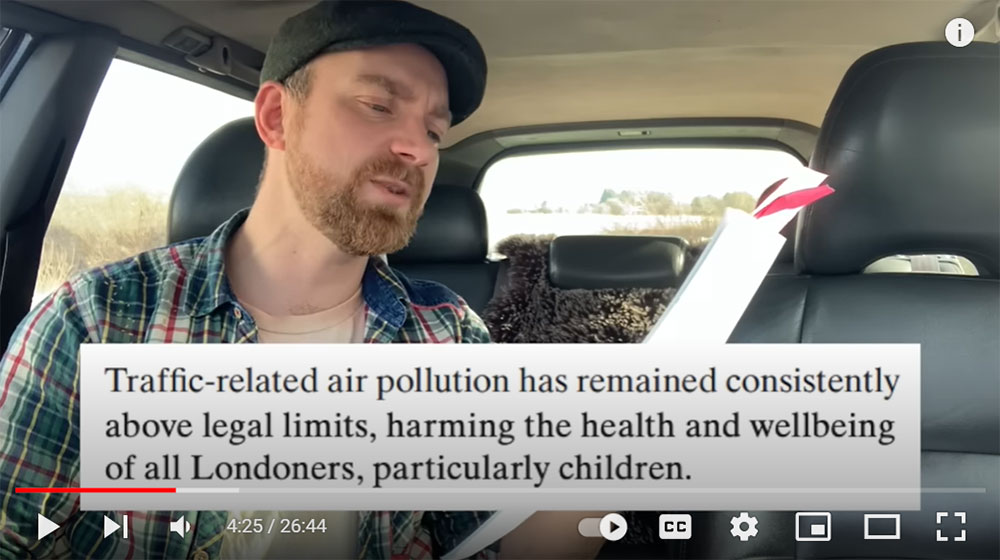
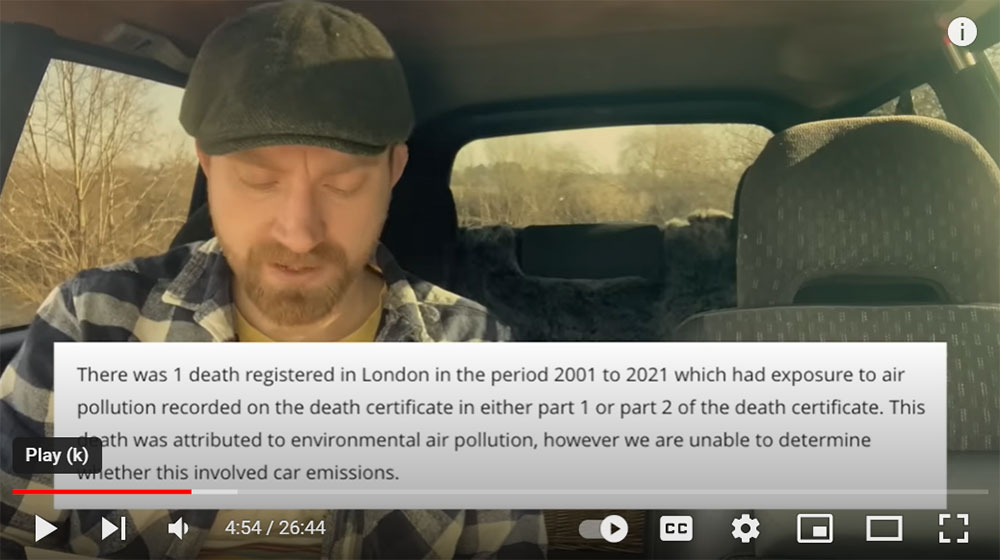
We shouldn’t. One thing we can do is put a face on the “one death” statistic. It is the face of a
nine-year-old child, Ella Kissi-Debrah, who lived in Lewisham - five train stops from Sidcup - and died
in 2013, after thirty hospital admissions, where her lungs would fill up with fluid and, on five occasions, collapse.
 It
took seven years and two inquests - not to mention incredible perseverance by Ella’s mother
Rosamund - to officially establish the reason for Ella’s deterioration and death. The following
paragraph comes from the coroner’s “Report to Prevent Future Deaths”:
It
took seven years and two inquests - not to mention incredible perseverance by Ella’s mother
Rosamund - to officially establish the reason for Ella’s deterioration and death. The following
paragraph comes from the coroner’s “Report to Prevent Future Deaths”:
“Ella died at the age of 9. She had severe, hypersecretory asthma causing episodes of respiratory and
cardiac arrest and requiring frequent emergency hospital admissions. On 15 February 2013 she had a
further asthmatic episode at home and was taken to hospital where she suffered a cardiac arrest
from which she could not be resuscitated. Air pollution was a significant contributory factor to both
the induction and exacerbations of her asthma. During the course of her illness between 2010 and
2013 she was exposed to levels of nitrogen dioxide and particulate matter in excess of World Health
Organization Guidelines. The principal source of her exposure was traffic emissions. During this
period there was a recognized failure to reduce the level of nitrogen dioxide to within the limits set
by EU and domestic law which possibly contributed to her death”.
Ella’s was a landmark case: air pollution was recorded on a death certificate for the first time in the
UK, and possibly for the first time in the so called “developed world”. This happened in 2021, the
latest year mentioned in Geoff’s document, so we don’t know if any more air-pollution-linked deaths
have been recorded since. I think we can be pretty sure that deaths like Ella’s had happened before - we just don’t know about them.
It doesn’t particularly matter. Ella’s case was extreme, with a fast, terminal decline of a happy child
living in London - next to a busy road - and a medical history showing correlation between asthma
attacks and Lewisham’s air-pollution levels. In the vast majority of cases, air pollution - especially
particulate-matter pollution, which can pass through the lungs into blood - steals life slowly,
sometimes affecting victim’s respiratory tract - think asthma and respiratory cancers - but as often
producing disease not obviously linked to breathing, such as non-respiratory cancers, heart attacks and strokes.
In 1992, UK’s Department of Health established a scientific advisory panel named Committee on the
Medical Effects of Air Pollutants, or COMEAP. Over the years, COMEAP has investigated toxic air’s
links to specific conditions (for example, bronchitis and dementia), and attempted to quantify its
health impact, focusing on the two key air pollutants, nitrogen dioxide and particulate matter. Several
reports published by COMEAP have suggested the UK-wide annual “mortality burden” (we will
discuss this later) of about 40,000 deaths.
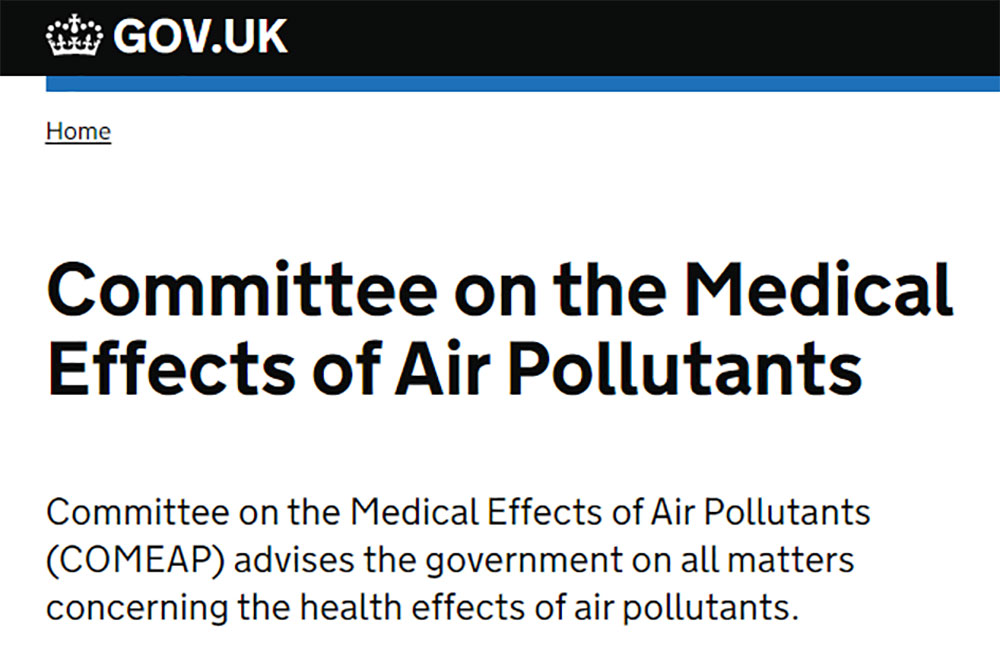

This is where Geoff gets his “40,000 deaths” number. However, it is an estimate for the whole of the
UK, not only for London. The latter can be found in a 2021 study by scientists from Imperial College,
who applied the latest COMEAP methodology to 2019 data for Greater London’s 600-plus wards.
The ICL study has a special significance for Sidcup, as it named Sidcup Ward, jointly with the
neighbouring Bickley Ward of Bromley, London’s worst in terms of mortality burden. (To the relief of
local estate agents, Sidcup is not explicitly named in the paper. I made a FOI request to TfL to get
ward-level numbers, which identified Sidcup and Bickley as the joint Number 1). Three more Bexley
wards - Bexleyheath, Crook Log, Blackfen and Lamorbey - made it to Top 20. (One would think that
the esteemed News Shopper takes note. Nope. Maybe it’s the estate-agent lobby after all).
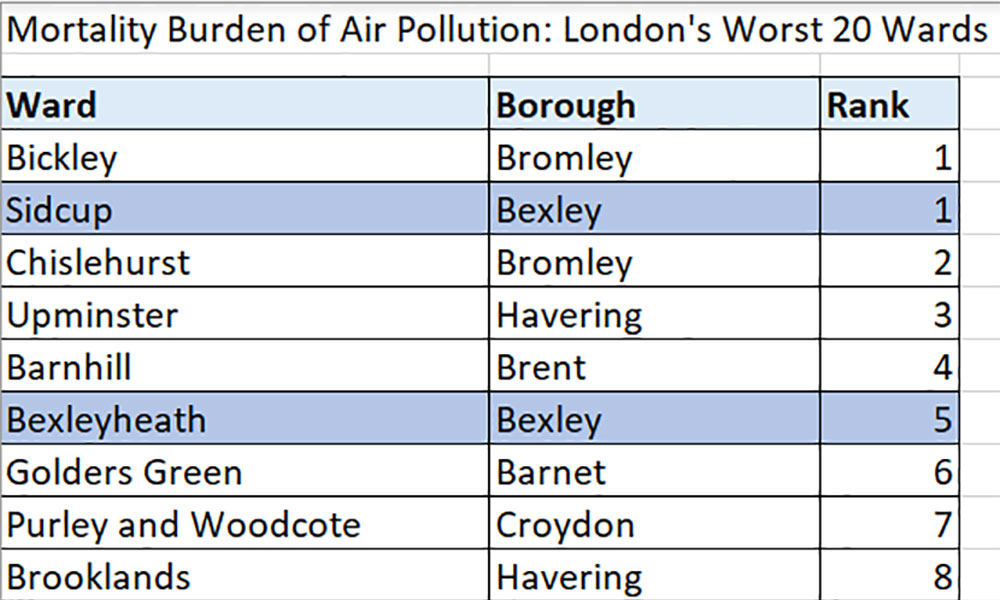
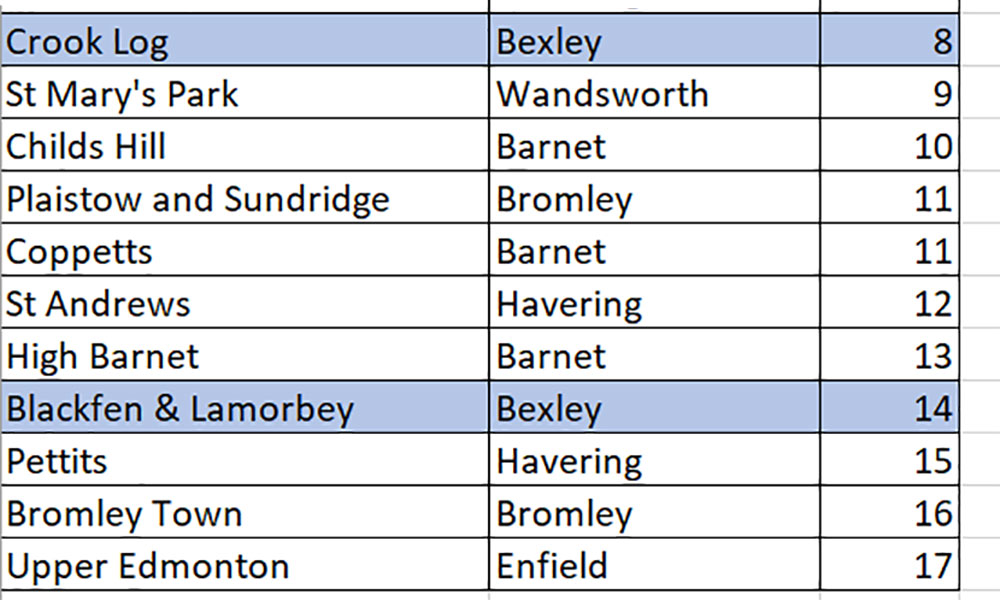
The first bullet point in the study’s “key findings” says: “In 2019, in Greater London, the equivalent of
between 3,600 to 4,100 deaths […] were estimated to be attributable to human-made PM2·5 and
NO2, considering that health effects exist even at very low levels. This calculation is for deaths from all
causes including respiratory, lung cancer and cardiovascular deaths”.
The calculation hangs on estimated “hazard rates”. Broadly, a hazard rate answers the question “How
much more likely is one to die if exposed to bad thing X?” A hazard rate “embeds” a specific time
horizon (e.g., one year), and, in the case of air pollution, is defined with regard to a specific
concentration of a specific pollutant. (Things get tricky when two or more pollutants “overlap”).
Notably, a hazard rate deals only with life and death; a temporary or permanent impairment of one’s
quality of life - consider living with asthma - is out of the picture, as long as one is alive.
What Geoff wants you to believe is that for air pollution, that hazard rate is essentially zero: with a
single death in two decades, in a city as big as London, there is really nothing to worry about!
Scientists have a very different view, and guess an about 05%-2% boost in one’s “natural” risk of
death over 1 year per 10 micrograms-per-cubic-metre (let me abbreviate this to “mgcm”) of nitrogen
dioxide, and an about 4-8% (6% is a popular number) boost in one’s “natural” risk of death over 1
year per 10 mgcm of fine particulate matter (PM2·5). The numbers come from several large
international (mostly American) epidemiological studies, and this is the closest we come to
“evidence” demanded by Geoff. It is not the kind of evidence that one can touch, but in science, this is not unusual.
(Is 10 mgcm a realistic level experienced by a Londoner - in particular, an Outer Londoner living far
from Zone 1? Consider Bexley’s Belvedere, where an air-quality monitoring station located in a
residential area registered on average 8 mgcm for PM2·5 and 23 mgcm for NO2 for 2023. So yes, 10
mgcm of PM2·5 or NO2 is not a high bar for London, Inner or Outer. It can be double, or triple, or
quadruple that - and that means multiplied risks!)
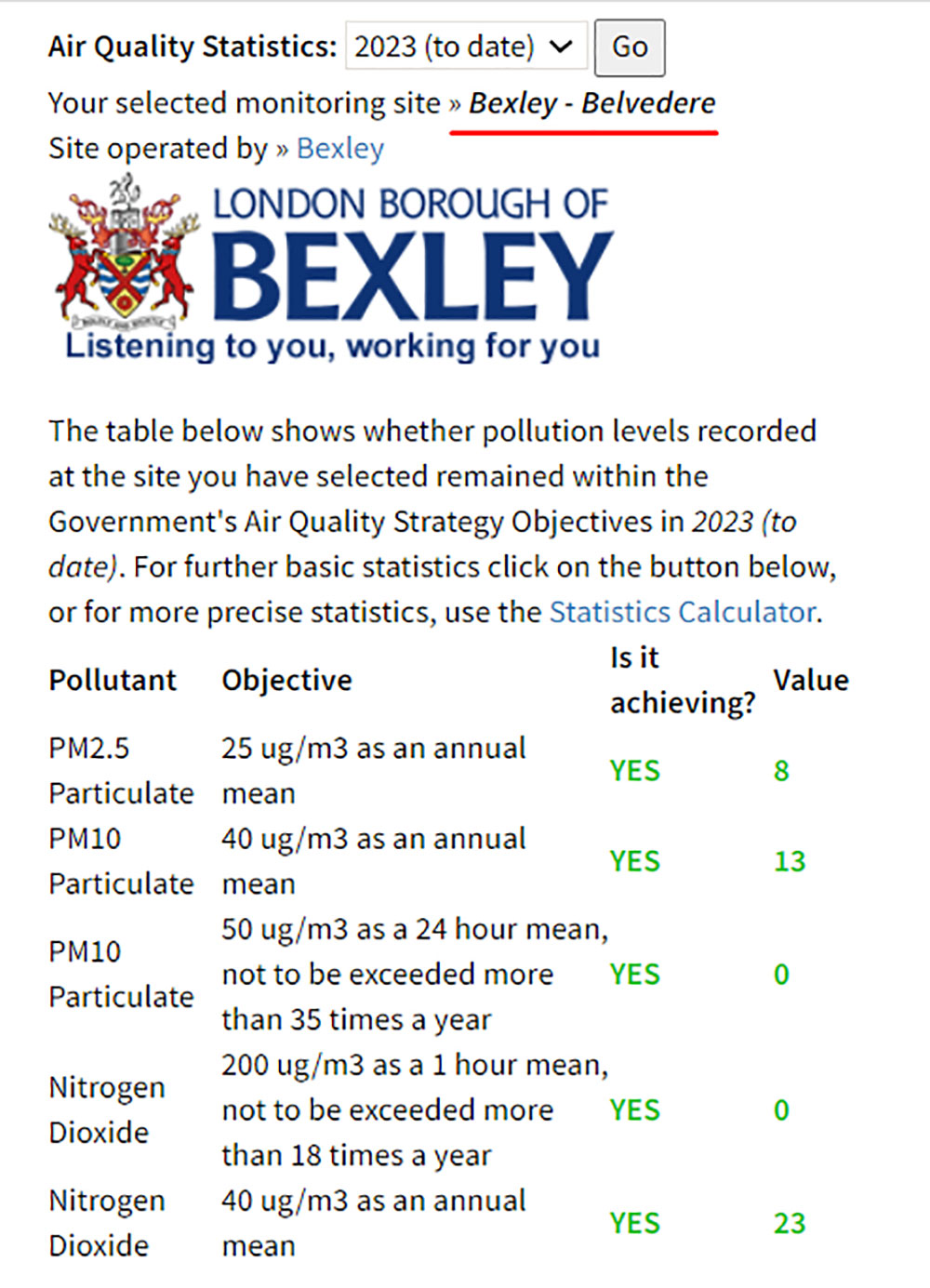 With hazard-rate estimates in hand, one can estimate the expected number of deaths assuming a
particular air-pollution level. Consider two points: the current air-pollution level, and the air-pollution
level assuming no human-made air pollution. Say, 200 Sidcup Ward residents are expected to die in
the “high pollution” scenario, and 190 people are expected to die in the “low pollution” scenario.
With hazard-rate estimates in hand, one can estimate the expected number of deaths assuming a
particular air-pollution level. Consider two points: the current air-pollution level, and the air-pollution
level assuming no human-made air pollution. Say, 200 Sidcup Ward residents are expected to die in
the “high pollution” scenario, and 190 people are expected to die in the “low pollution” scenario.
The difference (10) is the estimated mortality burden. Summed across London wards, one gets 4,000
premature deaths. (Not all of them are preventable. To calculate how many deaths a particular
clean-air policy can prevent - or rather postpone to their “normal” times - one needs to make a
forecast of the policy’s impact on air quality and use the resulting air-pollution level for a separate calculation).
In the end, there are no 4,000 death certificates with “air pollution” written on them. “4,000 deaths”
is an estimate made by a scientific study that used an accepted national methodology and
mainstream quantitative assumptions. As any estimate, this one can be off the mark, in either
direction. However, it is scientists’ best guess. Sadiq Khan and clean-air campaigners do not mislead
the public when they talk about 4,000 Londoners dying every year due to air pollution. Geoff and
people like Geoff - sadly, including Conservative politicians on the Bexley council, on the London
Assembly and in Parliament - do mislead the public when they discount the danger that air pollution
presents. Much worse, they (excluding Geoff this time) fail to act when inaction costs lives.
And speaking of Parliament… Ten years after Ella’s death, the Clean Air (Human Rights) Bill,
nicknamed Ella’s Law, sits on the waiting list at the House of Commons,
after approval by the House of Lords. It may get to a vote in late March. Which way do you think our MP
Louie French, who records anti-ULEZ videos and declares that “ULEZ is not about air quality” -
and was Bexley’s Cabinet Member for Growth while the council ignored its responsibility to develop
and act on an Air Quality Action Plan - is going to vote? I encourage you to email Louie at
louie.french.mp@parliament.uk and ask, before he jets off on another expenses-paid fact-finding journey. Some
facts worth finding, like Sidcup’s top spot in a grim league table, are right here.

 Health impact of air pollution is a complicated subject, and this essay could only scratch the surface.
If you wish to learn why the World Health Organisation and the British government agree on air
pollution being the top environmental health hazard of our time, you can Google COMEAP and WHO
reports. In the next post, we will look at ULEZ’s ability to improve the situation.
Health impact of air pollution is a complicated subject, and this essay could only scratch the surface.
If you wish to learn why the World Health Organisation and the British government agree on air
pollution being the top environmental health hazard of our time, you can Google COMEAP and WHO
reports. In the next post, we will look at ULEZ’s ability to improve the situation.
Links
Ella Kissi-Debrah
https://www.theguardian.com/environment/2020/dec/16/ella-kissi-debrah-mother-fight-justice-airpollution-death
Rosamund Kissi-Debrah
https://en.wikipedia.org/wiki/Rosamund_Kissi-Debrah
Coroner’s “Report to Prevent Future Deaths”
https://www.judiciary.uk/wp-content/uploads/2021/04/Ella-Kissi-Debrah-2021-0113-1.pdf
Committee on the Medical Effects of Air Pollutants (COMEAP)
https://www.gov.uk/government/groups/committee-on-the-medical-effects-of-air-pollutants-comeap
COMEAP again
https://ukwin.org.uk/resources/health/committee-on-the-medical-effects-of-air-pollutants-comeap/
COMEAP, “The mortality effects of long-term exposure to particulate matter
air pollution in the UK”, 2010
https://www.gov.uk/government/publications/comeap-mortality-effects-of-long-term-exposure-to-particulate-air-pollution-in-the-uk
Imperial College London, “London Health Burden of Current Air Pollution and
Future Health Benefits
of Mayoral Air Quality Policies”, 2021
http://erg.ic.ac.uk/research/home/resources/ERG_ImperialCollegeLondon_HIA_AQ_LDN_11012021.pdf
Ella’s Law
https://ellaslaw.uk






